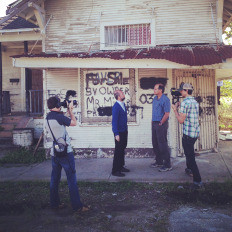Read Explorer Jon Waterman's insights

Explore/Protect: How can we Better Protect People From Extreme Weather Events?
After a recent fact-finding trip to New Orleans, I was shocked to learn how the decade old, moderate-sized Category 3 Hurricane Katrina has scarred the city. Seeing neighborhoods in ruins and meeting survivors still too traumatized to talk about the floods is a wake-up call into the socio-economic costs that we will confront in a future of global warming amplified natural disasters. Adapting to this challenge defines the work of the three researchers—atmospheric scientist Adam Sobel, social scientist Katrina Brown, and meteorologist Uwe Ulbrich—with whom I traveled to New Orleans.
Those who understand the science of changing climate know that natural disasters are expected to become more destructive by century’s end, as rising oceans, river floods, and extreme weather can increasingly turn ordinary storms into survival dilemmas for coastal communities. Tapping into the knowledge bank of these three scientists’ missions will allow engineers and other community leaders to safely develop vulnerable cities, build sustainable protective infrastructure (such as levees and pumps), design proper early warning evacuation systems and help vulnerable populations better adapt. So, in April, as I came to understand the essential work of these three scientist-professors, the four of us (trailed by the talented filmmakers Andy Maser and Hayden Peters), familiarized ourselves with the city known as the Big Easy.
Founded in 1718 by the French on the Mississippi River Delta, New Orleans is surrounded by the tidal waters of Lake Pontchartrain and is perched on a high river bank that protected early settlers from floods. However, over the next few centuries, settlement spread out onto more flood-prone and sub-sea-level ground. More recently, oil development cut thousands of miles of canals into the delta—which meant that New Orleans lost its most valuable defence against tidewater storm floods: the Mississippi River Delta.
Since the 1930s, the city has lost as much delta land as that contained in the whole state of Delaware (1,900 square miles, or 1,216,000 acres). It is continuing to vanish, we learned, at the rate of two acres per hour. And although the city had been ringed with levees, mistakes in the design and construction of these concrete walls were to prove deadly. After Hurricane Katrina passed and ocean water surged against these walls, most of them collapsed, flooding 80 percent of the city. So, inexcusably, it was faulty human actions–destruction of the delta, lack of evacuation preparedness, and improperly built levees–rather than the hurricane–that caused the catastrophe.
Before visiting New Orleans I was inclined to view Katrina’s fading footprint as yet another natural disaster amid a cacophony of increasingly severe storms, possibly related to climate change. But in New Orleans I learned that it was more complex, and that the damage was directly tied to what experts call “the largest civil engineering disaster in the history of the United States.”
As Adam (47, U.S.), Kate (52, U.K.), and Uwe (55, Germany) and I walked, rode boats, and drove around the Gulf Coast, I discovered that all three are devoted parents, showing that their climate change work today is directly related to their children’s future, even though (as Kate adamantly believes, speaking for her two colleagues) that you don’t need to become a parent to be concerned about climate change. Strikingly modest, they were unwilling to generalize that Katrina was caused, let aloneheightened by climate change.
The three also exhibited great senses of humor—Uwe’s delightful smile, Kate’s characteristic laughter, and Adam’s unassuming nature—and willingness to listen to live music in the back alleys of the French Quarter, sampling alligator cheesecake, jambalaya, and crawfish étouffée that are the culinary hallmarks of a Big Easy visit.
Together, we observed the Hurricane’s lasting impact, still patently obvious nine years later. We learned to decipher the tic-tack-toe -shaped, spray-painted symbols adorning numerous houses, signed and dated by rescue teams and denoting whether human or animal corpses were inside. We heard the clang and roar of heavy machinery throughout the city as construction continued on levee walls, homes and schools. Stove-in boats and flood debris still littered what seemed like high ground. And in the surrounding bayou, where rooftops could be seen poking out of the waters, those newly built and surviving houses were recently raised up on high stilts, anticipating the next flood.
According to FEMA (the Federal Emergency Management Agency), Hurricane Katrina remains “the single most catastrophic natural disaster in U.S. history.” Eighteen hundred and thirty-three people lost their lives. And over a million people were displaced from their homes; many have not returned.
Clearly, Uwe, Adam, and Kate represent the vanguard of modern scientists whose work could save both lives and billions of dollars in federal aid and insurance costs (it’s no coincidence that all three scientists receive research support from the AXA Research Fund, a science philanthropy initiative of the global insurance leader, AXA). Hurricane Katrina cost insurance companies $41 billion, while the National Flood Insurance Program paid out $16 billion amid $108 billion in other federal government relief funding, making it the costliest hurricane in U.S. history.
More than anything else, I learned that we can minimize future natural disasters related to climate change. Provided, as Adam wrote in his forthcoming book Storm Surge, that our leaders can separate “the practice, conscious or unconscious, of basing one’s understanding of the science on one’s political views.”
Discover research projects related to the topic
Mécénat des Mutuelle
France
CLIMABRAIN: Impacts of Extreme Weather on the Most Vulnerable Living with Alzheimer's disease
In the context of the increase in extreme weather events due to climate change, the project led by Tarik Benmarhnia... Read more

Tarik
BENMARHNIA

